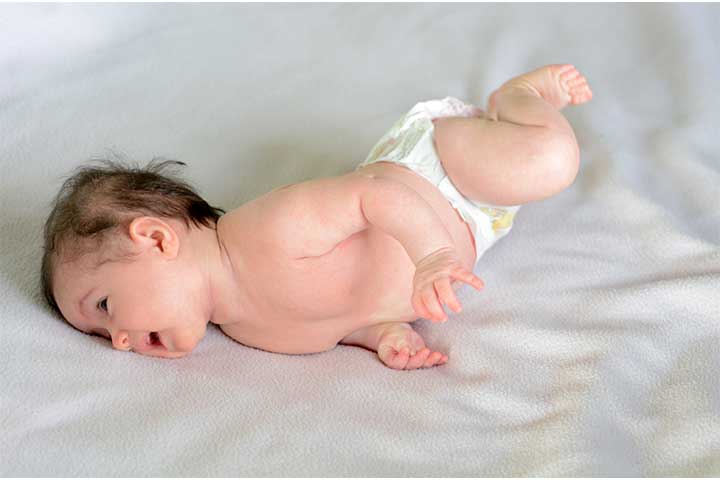
Image: Shutterstock
As a parent, the journey of watching your little one achieve milestones is a breathtaking experience. One of these thrilling feats is the moment when your baby rolls over for the first time. Witnessing this milestone feels like having a peek into their growing physical abilities and cognitive development. Let’s take a closer look at the fascinating world of baby rolling, from when it happens to what comes next. Read on to know more about this!
When Do Babies Roll Over? The Exciting Milestone
The moment your baby rolls over is a cherished memory. This remarkable milestone typically occurs between 4 to 6 months of age (1). However, remember that every baby is unique and may achieve this feat a little earlier or later. It’s essential not to compare your baby’s progress to others, as each little is on their own timeline.
How Babies Learn To Roll Over: The Intricate Process
Image: Shutterstock
The journey of rolling over is a fascinating one, characterized by distinct stages of development. Understanding these stages can offer insights into your baby’s progress and help you support them along the way.
1. Newborn: Laying The Foundation
In the earliest weeks of life, newborns have limited control over their bodies. They spend most of their time lying on their backs, exploring their surroundings through their senses. During this phase, your baby begins to develop neck strength as they lift and turn their head in response to sounds and sights.
2. 1 To 2 Months: Building Upper Body Strength
As your baby reaches the 1- to 2-month mark, they start showing signs of increased upper body strength. During tummy time, they push up on their forearms, gradually lifting their head higher. This not only strengthens their neck muscles but also fosters development of the core muscles needed for rolling.
3. 3 To 4 Months: The Rocking Phase
Around 3 to 4 months, you may notice your baby engaging in rhythmic rocking motions while lying on their back. This movement is an essential precursor to rolling over. They push their legs to one side, attempting to turn over. While they may not achieve a full roll yet, this rocking motion signifies their increasing awareness of their body’s mobility.
4. 5 To 6 Months: The Exciting Milestone
Between 5 to 6 months, many babies achieve the remarkable milestone of rolling over for the first time. With improved neck and upper body strength, along with their newfound ability to coordinate their movements, they manage to propel themselves from back to tummy or vice versa. This achievement signifies the culmination of their early developmental efforts.
How To Help Your Baby With Rolling Over: Encouraging Their Efforts
Image: Shutterstock
You can play an active role in supporting your baby as they embark on their rolling journey. Give them plenty of supervised tummy time to develop those essential neck and upper body muscles. Place enticing toys just out of reach to encourage them to reach and explore. Placing your baby on a safe, flat surface, like a play mat, encourages them to engage in this natural exploration.
Keeping Your Baby Safe When Rolling Over: A Priority
As your baby starts to roll over, safety becomes paramount. Make sure their crib and play area are free of loose bedding, toys, or any other potential hazards. It’s also an excellent time to consider using sleep sacks instead of blankets to ensure they stay cozy and safe while sleeping. Always supervise tummy time and rolling activities to prevent any accidents.
What To Do If Your Baby Doesn’t Roll Over: Understanding Variability
Every baby develops at their own pace, and not rolling over by a specific age doesn’t necessarily indicate a problem. Some babies take a little longer to master this skill. However, if you’re concerned about your baby’s development, it’s always wise to consult your pediatrician. They can provide valuable guidance and address any concerns you might have.
After Your Baby Starts Rolling Over, What’s Next? The Adventure Continues
Image: Shutterstock
Once your baby conquers rolling over, a whole new world of exploration opens up. Rolling is often the precursor to more complex movements, like sitting up, crawling, and eventually walking. It’s a thrilling time for both you and your baby as they learn to navigate their surroundings in new and exciting ways. Be prepared for increased curiosity and a heightened desire to interact with their environment.
The journey of a baby rolling over is an amusing phase filled with wonder and excitement. Remember that each baby progresses at their own pace, and celebrating their unique milestones is the true essence of parenthood. As your baby learns to roll over and explore, ensure their safety and provide them with a supportive environment to thrive in. Cherish these moments and look forward to the countless adventures that lie ahead as your little one continues to grow and discover the world around them.















